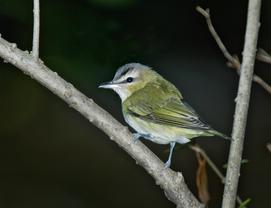RED-EYED VIREO VA-11
Appalachia: Breaks Interstate Park and vicinity, far western Virginia
May 28, 5:59 a.m.
Sunrise at 6:14 a.m.
Here is yet another red-eyed vireo. They're everywhere, lining the road, and I can never resist listening to a singing red-eyed vireo.
With this bird, too, as with all red-eyed vireos, I listen for a handle in his repertoire, a distinctive song that lets me follow along. I like the fourth song in the series. It's sufficiently different from the others--it's a rising, tonal note, and simple. I begin counting on the next song and count until I hear it again, and there it is, on the 14th song after the first one. I continue counting in this way, from one occurrence of this song to the next: 18, 12, 16, 18, 16, 14, 16, 9, 19, 15, 21, 20, 38, 16, 12, 13, 20, 10, 15, 16, 19, reaching the end of the five and a half minutes. The most common number (mode) is 16, which means that he "typically" sings 16 songs before starting to repeat the songs in his repertoire. The number 16 is also the median value (the average is 16.7). I bet a thorough study of the songs in this male's repertoire would yield a repertoire fairly close to 16 different songs.
The double-noted song at 0:02 is also distinctive, as is the song with the two high double notes at 0:09. Go ahead, listen to this recording again, and again, and you'll begin to hear more and more unique songs that recur throughout these five and a half minutes of this red-eyed vireo's singing life.
You'll gain such an appreciation for red-eyed vireos that you'll never again mistake one for any of the "sound-alike species," such as robin or tanager. Nor will any singing red-eyed vireo be dismissed as "just another red-eyed vireo," because you'll inevitably listen for the "handle" in the singing of each individual.
It is this deep listening that provides an especially satisfying window into the mind of an individual singing bird, and simultaneously provides a fail-safe approach to "birding by ear," i.e., recognizing different species by their songs and calls alone.
Background
Hooded warbler, wood thrush, ovenbird, drumming woodpecker, scarlet tanager, barred owl.

Photo by John Van de Graaff
